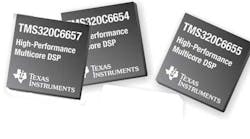Texas Instruments’ multicore system-on-chip (SoC) processors are one good way to implement radios for the new white space wireless standards. TI’s KeyStone line consists of a mix of DSPs and RISC processors that can be programmed to meet current and forthcoming white space standards.
White space refers to the unused TV broadcast channels in the 54- to 698-MHz spectrum. These 6-MHz channels aren’t fully assigned in many cities across the country, making them available for other wireless applications such as broadband Internet access, Wi-Fi backhaul, and machine-to-machine communications (M2M). The Federal Communications Commission (FCC) approved use of the white spaces in 2010 as long as the radios meet exacting specifications.
These specifications require radios to be able to sense the status of an unused channel to ensure there is no interference with another station. If the channel is occupied, the radio moves on until it finds an available one using GPS location and a national database of stations. This combination of dynamic spectrum sensing, frequency agility, and database access requires the radios to incorporate features generally referred to as cognitive radio. Cognitive radio is software-defined radio that’s aware of its surroundings and able to adapt to the environment while meeting rules and regulations. One approach to implementing cognitive radio features is the use of available SoCs.
TI’s KeyStone-based TMS320TCI6614 and TMS320TCI6612 SoCs encompass a mix of radio accelerators, network and security coprocessors, and fixed-and floating-point DSPs and an ARM RISC processor. They provide the ideal foundation for layers 1, 2, and 3 and transport processing for cognitive radio.
TI’s TMS320C665x processors are well suited for cognitive radio (see the figure). They consist of three fully pin-compatible low-cost, power-optimized solutions for engineers migrating from single core to multicore. It features two 1.25-GHz DSP cores, delivering up to 80 GMACs and 40 GFLOPs, while the C6655 and C6654 single-core solutions deliver up to 40 GMACs and 20 GLOPs and 27.2 GMACs and 13.6 GFLOPs, respectively. Under normal operating conditions, the C6657, C6655, and C6654 power numbers are at 3.5 W, 2.5 W, and 2 W.
Azcom Technology, one of TI’s Design Network partners, is using these SoCs to design cognitive white space radios based on the IEEE 802.22 Wireless Regional Area Networks (WRAN) standard. Sometimes referred to as Wi-Far, a term of the White Space Alliance, it is derived from the 802.22 standard and shows promise to become a leading standard for white space radios.
Azcom’s cognitive radio platform is made up of a hardware board based on TI’s cost-efficient TMS320TCI6614 wireless infrastructure SoC and complete PHY/MAC layer stacks. Azcom’s platform enables the TV white space market to develop devices with a range up to 100 km. With built-in PHY and MAC layer stacks, the SoCs relieve developers of the need to worry about DSP processing since it is all taken care of in layer 1, making the design process easier and quicker, according to the company.
If you’re contemplating the design of a white space radio, this is one approach worth considering as the white space standards, rules, and regulations are subject to changes as the FCC considers auctioning off the white space spectrum and re-farming the various frequency assignments. Programmable SoCs can get the job done in minimum time with minimum effort while future-proofing the design.
For more details, see www.ti.com/multicore and www.azcom.it.
